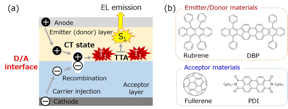Home > Press > Organic light emitting diodes operated by 1.5 V battery
 |
| Fig. 1 (a) Schematic of the device structure and the operating mechanism of OLEDs. (b) Chemical structures.
CREDIT NINS/IMS |
Abstract:
Various properties of organic light-emitting diodes (OLEDs) have been optimized, including current to photon conversion efficiency. An external quantum efficiency exceeding 20%, with internal quantum efficiency of 100%, has been achieved owing to the development of thermally activated delayed fluorescent and phosphorescent materials that manage the spin of excited states. However, the operating voltage of common types of OLEDs is very high; that of an OLED emitting approximately 600-nm light at a luminance of 100 cd/m2, which is a general display condition, is as high as 4.5 V.
Organic light emitting diodes operated by 1.5 V battery
Tokyo, Japan | Posted on January 7th, 2022
Group of Assistant Professor Seiichiro Izawa and Professor Masahiro Hiramoto at Institute for Molecular Science in Japan, and Associate Professor Masahiro Morimoto and Professor Shigeki Naka at University of Toyama in Japan report that an efficient OLED, operable by a 1.5-V battery, that produces bright emission equivalent to luminance of a typical display. The OLED has a smaller turn-on voltage at 0.97 V than the optical energy of emitted photons at 2.04 eV (608 nm), because the OLED is based on upconversion (UC) transition associated with triplettriplet annihilation that doubles the energy of excited states (Fig. 1). They reveal that the characteristics of charge transfer (CT) state at the interface are key to efficient UC, and the percentage of excited states deactivated by parasitic loss processes during the UC transition is significantly reduced from over 90% to approximately 10% by introducing a highly crystalline acceptor material and an emissive dopant. Consequently, the UC-OLED reaches 100 cd/m2 at a voltage and emission wavelength of 1.33 V and 608 nm (2.04 eV), respectively (Fig. 2a). This is the lowest operating voltage reported for an OLED that achieves a luminance of 100 cd/m2. It was further demonstrated that the UC-OLED can be operated by a 1.5-V battery to realize luminance of 177 cd/m2 (Fig. 2b).
####
For more information, please click here
Contacts:
Hayao KIMURA
National Institutes of Natural Sciences
Office: 81-354-251-890
Expert Contact
Seiichiro Izawa
Institute for Molecular Science
Office: +81-564-59-5537
Copyright © National Institutes of Natural Sciences
If you have a comment, please Contact us.
Issuers of news releases, not 7th Wave, Inc. or Nanotechnology Now, are solely responsible for the accuracy of the content.
News and information
![]()
Researchers detect two-dimensional kagome surface states January 7th, 2022
![]()
Mass production of revolutionary computer memory moves closer with ULTRARAM on silicon wafers for the first time January 7th, 2022
![]()
Super-resolved imaging of a single cold atom on a nanosecond timescale January 7th, 2022
Display technology/LEDs/SS Lighting/OLEDs
![]()
Fabricating stable, high-mobility transistors for next-generation display technologies December 17th, 2021
![]()
New substance classes for nanomaterials: Nano spheres and diamond slivers made of silicon and germanium: Potential applications as nano semiconductor materials September 10th, 2021
![]()
Controlling chaos in liquid crystals, gaining precision in autonomous technologies August 6th, 2021
Organic Electronics
![]()
Efficient photon upconversion at an organic semiconductor interface November 19th, 2021
Possible Futures
![]()
Physicists watch as ultracold atoms form a crystal of quantum tornadoes: The new observations record a key crossover from classical to quantum behavior January 7th, 2022
![]()
Intense monocycle terahertz pulses from shifting electrons in quantum structures January 7th, 2022
![]()
In vivo generation of engineered CAR T cells can repair a broken heart January 7th, 2022
![]()
A single molecule makes a big splash in the understanding of the two types of water January 7th, 2022
Discoveries
![]()
Physicists watch as ultracold atoms form a crystal of quantum tornadoes: The new observations record a key crossover from classical to quantum behavior January 7th, 2022
![]()
Intense monocycle terahertz pulses from shifting electrons in quantum structures January 7th, 2022
![]()
Researchers detect two-dimensional kagome surface states January 7th, 2022
Announcements
![]()
Researchers detect two-dimensional kagome surface states January 7th, 2022
![]()
Mass production of revolutionary computer memory moves closer with ULTRARAM on silicon wafers for the first time January 7th, 2022
![]()
Terahertz light-driven spin-lattice control: A new potential path to faster and more efficient data storage January 7th, 2022
![]()
In vivo generation of engineered CAR T cells can repair a broken heart January 7th, 2022
Interviews/Book Reviews/Essays/Reports/Podcasts/Journals/White papers/Posters
![]()
Mass production of revolutionary computer memory moves closer with ULTRARAM on silicon wafers for the first time January 7th, 2022
![]()
Super-resolved imaging of a single cold atom on a nanosecond timescale January 7th, 2022
![]()
Terahertz light-driven spin-lattice control: A new potential path to faster and more efficient data storage January 7th, 2022
![]()
In vivo generation of engineered CAR T cells can repair a broken heart January 7th, 2022










